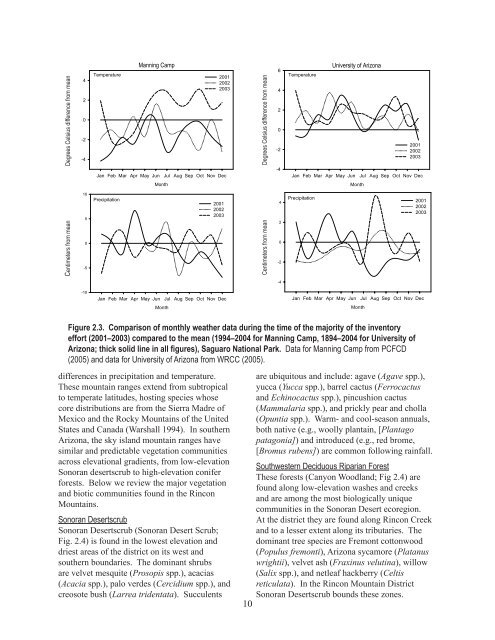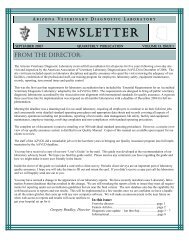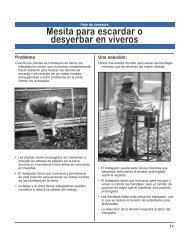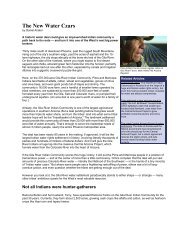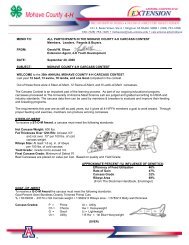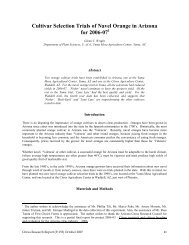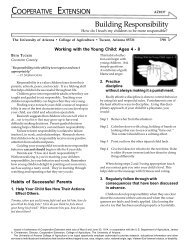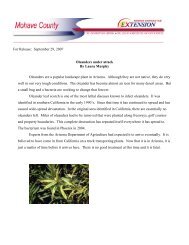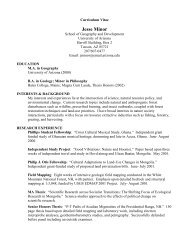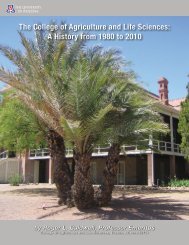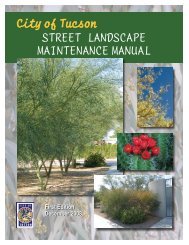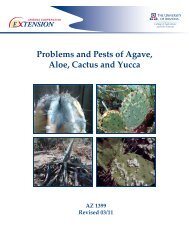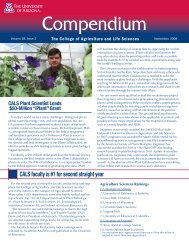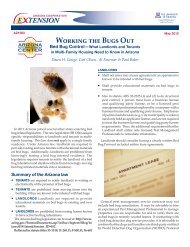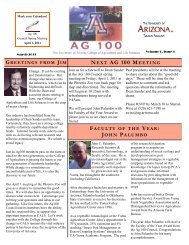Details - CALS Networking Lab - University of Arizona
Details - CALS Networking Lab - University of Arizona
Details - CALS Networking Lab - University of Arizona
You also want an ePaper? Increase the reach of your titles
YUMPU automatically turns print PDFs into web optimized ePapers that Google loves.
Centimeters from mean Degrees Celsius difference from mean<br />
4<br />
2<br />
0<br />
-2<br />
-4<br />
10<br />
5<br />
0<br />
-5<br />
-10<br />
Temperature<br />
Jan Feb Mar Apr May Jun Jul Aug Sep Oct Nov Dec<br />
Precipitation<br />
Manning Camp<br />
Month<br />
2001<br />
2002<br />
2003<br />
2001<br />
2002<br />
2003<br />
Jan Feb Mar Apr May Jun Jul Aug Sep Oct Nov Dec<br />
Month<br />
Figure 2.3. Comparison <strong>of</strong> monthly weather data during the time <strong>of</strong> the majority <strong>of</strong> the inventory<br />
effort (2001–2003) compared to the mean (1994–2004 for Manning Camp, 1894–2004 for <strong>University</strong> <strong>of</strong><br />
<strong>Arizona</strong>; thick solid line in all figures), Saguaro National Park. Data for Manning Camp from PCFCD<br />
(2005) and data for <strong>University</strong> <strong>of</strong> <strong>Arizona</strong> from WRCC (2005).<br />
differences in precipitation and temperature.<br />
These mountain ranges extend from subtropical<br />
to temperate latitudes, hosting species whose<br />
core distributions are from the Sierra Madre <strong>of</strong><br />
Mexico and the Rocky Mountains <strong>of</strong> the United<br />
States and Canada (Warshall 1994). In southern<br />
<strong>Arizona</strong>, the sky island mountain ranges have<br />
similar and predictable vegetation communities<br />
across elevational gradients, from low-elevation<br />
Sonoran desertscrub to high-elevation conifer<br />
forests. Below we review the major vegetation<br />
and biotic communities found in the Rincon<br />
Mountains.<br />
Sonoran Desertscrub<br />
Sonoran Desertscrub (Sonoran Desert Scrub;<br />
Fig. 2.4) is found in the lowest elevation and<br />
driest areas <strong>of</strong> the district on its west and<br />
southern boundaries. The dominant shrubs<br />
are velvet mesquite (Prosopis spp.), acacias<br />
(Acacia spp.), palo verdes (Cercidium spp.), and<br />
creosote bush (Larrea tridentata). Succulents<br />
10<br />
Centimeters from mean Degrees Celsius difference from mean<br />
Centimenters from mean<br />
6<br />
4<br />
2<br />
0<br />
-2<br />
-4<br />
4<br />
2<br />
0<br />
-2<br />
-4<br />
Temperature<br />
Jan Feb Mar Apr May Jun Jul Aug Sep Oct Nov Dec<br />
Precipitation<br />
<strong>University</strong> <strong>of</strong> <strong>Arizona</strong><br />
Month<br />
2001<br />
2002<br />
2003<br />
2001<br />
2002<br />
2003<br />
Jan Feb Mar Apr May Jun Jul Aug Sep Oct Nov Dec<br />
Month<br />
are ubiquitous and include: agave (Agave spp.),<br />
yucca (Yucca spp.), barrel cactus (Ferrocactus<br />
and Echinocactus spp.), pincushion cactus<br />
(Mammalaria spp.), and prickly pear and cholla<br />
(Opuntia spp.). Warm- and cool-season annuals,<br />
both native (e.g., woolly plantain, [Plantago<br />
patagonia]) and introduced (e.g., red brome,<br />
[Bromus rubens]) are common following rainfall.<br />
Southwestern Deciduous Riparian Forest<br />
These forests (Canyon Woodland; Fig 2.4) are<br />
found along low-elevation washes and creeks<br />
and are among the most biologically unique<br />
communities in the Sonoran Desert ecoregion.<br />
At the district they are found along Rincon Creek<br />
and to a lesser extent along its tributaries. The<br />
dominant tree species are Fremont cottonwood<br />
(Populus fremonti), <strong>Arizona</strong> sycamore (Platanus<br />
wrightii), velvet ash (Fraxinus velutina), willow<br />
(Salix spp.), and netleaf hackberry (Celtis<br />
reticulata). In the Rincon Mountain District<br />
Sonoran Desertscrub bounds these zones.


